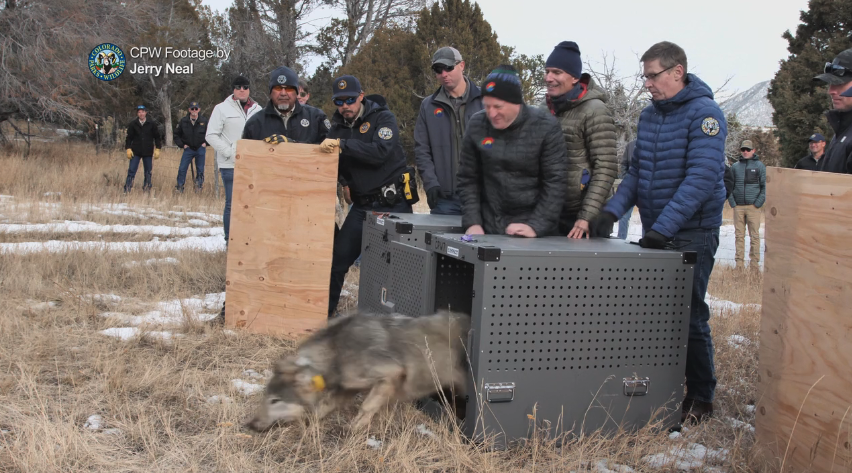DENVER — A collar on a released gray wolf in Colorado is no longer providing a signal and another collar is partially functioning and may fail soon, Colorado Parks and Wildlife said in a Wednesday update about the animals' activity.
CPW said its biologists are no longer seeing a signal from one of the collars placed on a wolf transplanted from Oregon, however they can tell that it is traveling with a second wolf, which does have a functioning collar. CPW officials have seen the wolf with the malfunctioning collar from an airplane, so they have confirmed it is still alive, the agency said.
In addition, a collar on a different wolf appears to be partially functioning and "may not be fully functional in the near future," CPW said.
All of the wolves that have been released in Colorado are still alive and CPW has not received any reported livestock depredations since they were reintroduced in December.
Travis Duncan with CPW said the collars are expected to last up to three years.
"Collars can fail for all kinds of reasons and it is a common occurrence with all animals we collar," he said. "Wolves are pretty rough on collars and will chew on them, which can cause them to stop functioning correctly. As with all electronic equipment, there is an inherent risk of failure, which may include (but not be limited to) battery issues to loose circuitry or lack of connectivity over time. We do not know an exact reason for this failure."
Re-collaring the wolves with new equipment could pose "an unnecessary risk to any potential reproduction," he added. So CPW will not try to fit those two wolves with new collars.
Reid DeWalt, CPW’s assistant director of aquatic, terrestrial, and natural resources, said during the mid-March CPW Commission meeting that the agency hopes to set up four additional supply houses — or stash houses — in addition to the four already in place as calving season approaches for livestock producers. These supply houses hold wolf depredation prevention materials that can be easily provided to producers if any wolf conflicts arise, DeWalt said.

Local
CPW updates on wolf reproduction, conflict minimization, community outreach
DeWalt said one common question CPW has fielded centers around if packs or pairs are forming. Wolf breeding typically falls in mid-February, but CPW said it is too early to determine if any of them have bred. The animals have a roughly 60-day gestation period. By mid-April, CPW may have more information about any potential dens and reproduction, DeWalt said during the commission meeting.
As part of the state's voter-mandated reintroduction effort, CPW released its first five gray wolves on Dec. 18, 2023 at an undisclosed place in Grand County. Five more were released a few days later in Grand and Summit counties. All 10 were collared. The state secured an additional 15 from tribal lands in northeastern Washington to reintroduce next winter. This is all in the wake of the May 2023 approval of the Colorado Wolf Restoration and Management Plan.
CPW released an updated map on Wednesday to show how the gray wolves have traveled in the past month. Below is a map from late February on the left, and Wednesday's released map on the right.

These maps, first released at the start of the year, are updated every 30 days and published on the fourth Wednesday of every month. They use GPS data from the collars to show the watersheds where the wolves have explored in the past 30 days.
"Watersheds are the appropriate mapping unit to display wolf activity information because wolves are far more likely to use geographic features to affect their distribution than they are political boundaries," CPW explained. "For a watershed to indicate wolf activity, at least one GPS point from the wolf collars was recorded within the watershed's boundaries. Because a watershed indicates wolf activity, it does not mean that a wolf or wolves are present throughout the entire watershed or that they are currently in it."
CPW has a Wolf Educational Resources page, where you can find videos on wolf biology and the reintroduction planning process. The department encourages the public to report any wolf sightings, especially with photos or videos. To submit one, visit CPW.info/wolf-sighting.






